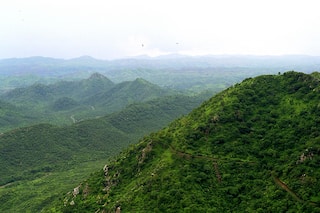Explorer
Delhiites to inhale more toxins as air quality deteriorates
National capital is set to inhale more toxins in next three days due to unfavourable changes in weather conditions and the stubble burning that continues unabated in Delhi-NCR itself

Image: AFP
New Delhi: With at least six areas witnessing "severe-plus or emergency" and "severe" category of air quality on Monday, the national capital is set to inhale more toxins in next three days due to unfavourable changes in weather conditions and the stubble burning that continues unabated in Delhi-NCR itself. According to the data from Central Pollution Control Board, the Air Quality Index (AQI) across Delhi-National Capital Region continued to be "very-poor" with a higher concentration of pollutant even during the daytime. The major pollutant PM2.5, or particles in the air with diameter less than 2.5 micrometers, had an average value of 216 units across Delhi-NCR, while it was 219 in Delhi alone at 2 p.m. Anand Vihar in east Delhi, Delhi Technical University in North Delhi and Ghaziabad in Uttar Pradesh have "severe-plus or emergency" air quality. While Punjabi Bagh in west Delhi and R.K. Puram in south Delhi and Sector 25 in Uttar Pradesh's Noida has "severe" air quality at 2 p.m. According to System of Air Quality and Weather Forecasting And Research (SAFAR), with no scope of improvement, Delhi-NCR's air quality is set to deteriorate over the next three days. With PM2.5 value ranging between 315 to 376 units at 2 p.m. at all ten monitoring stations of SAFAR across Delhi-NCR, the monitoring agency advises "no outdoor physical activity and less indoor activities" for the sensitive groups, and advises mask to everyone else. The regions with respective PM2.5 values include Dhirpur (319), Pitampura (353) and Delhi University (358) in North Delhi; Pusa (319) and Lodhi Road (315) in central Delhi; and Mathura Road (376) and Ayanagar (347) in south Delhi. Meanwhile, at IGI Airport PM2.5 was 354, at Gurgram in Haryana it was 350 and Noida it was 323 units -- all at least 12 to 13 times higher than the permissible limits. The safe range for PM2.5 as per International Standards is 25 microgrammes per cubic meters and 60 units as per national standards. "Stop outdoor activity at early morning and after sunset times. Go for a short walk instead of a jog and take more breaks," said a SAFAR's medical advisory meant for everyone. "Stop any activity level if you experience any unusual coughing, chest discomfort, wheezing, breathing difficulty, or fatigue. Avoid burning of wood, candles or incense. Masks known as N-95 or P-100 respirators may only help if you go out." The satellite images from NASA continue showing incidents of stubble burning in southern Delhi over the past week, as well as across Punjab and Haryana. According to the weather analysts, while Delhi's wind directions changed now from north-westerly (coming from Punjab) into westerly, the air pollution will still increase over the next two days due to increase in moisture. "By (November) 29, the winds will change again into high moisture South-westerly winds, which will form mist or haze in the region. With high humidity, air's capacity to hold pollutant increases," Mahesh Palwat, director private weather forecasting agency Skymet told media.
Follow Breaking News on ABP Live for more latest stories and trending topics. Watch breaking news and top headlines online on ABP News LIVE TV
Read more
Top Headlines
News
News
India
Maharashtra






































